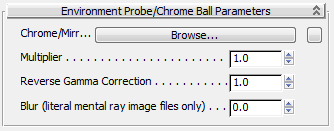This shader is intended as an environment shader (apply as an Environment Map), because it looks up based on the ray direction. It maps the proper direction to a point on the chrome ball and retrieves its color.
In the visual effects industry it is common practice to photograph a chrome ball (also known as a “light probe”) on set, as well as a gray ball for lighting reference.
Ideally, one shoots these at multiple exposures and uses software such as Photosphere (Macintosh) or HDRShop (PC) to combine them into a single high-dynamic-range image and/or unwrap the chrome/gray ball into a spherical environment map.
However, it is often difficult to regain the proper orientation of spherical map so it matches the camera used to render the CG scene. Furthermore, a single photo of a chrome/gray ball contains poor data for certain angles that one might want to avoid seeing in the final render.
These shaders are intended to simplify a special case: When the chrome/gray ball is already shot from the exact camera angle from which the final image is to be rendered.
It simply utilizes the mental ray camera coordinate space and applies the chrome/gray ball in this space, hence the orientation of the reflections will always “stick” to the rendering camera.
For additional information and illustrations, see Help menu  Additional Help
Additional Help  mr Production Shader Library
mr Production Shader Library  Chapter 6: Mirror/Gray Ball Shaders.
Chapter 6: Mirror/Gray Ball Shaders.
Interface

- Chrome/Mirror Ball Image
-
Click the Browse button to specify the file containing the chrome ball image. The image should be cropped so the ball exactly touches the edges of the image. Alternatively, click the map button to specify a procedural map.
- Multiplier
-
A multiplier for the chrome ball image.
- Reverse Gamma Correction
-
Applies an inverse gamma correction to the texture.
- Blur (literal mental ray image files only)
-
Blur the image. This applies only to literal mental ray textures; that is, bitmap images specified with the Browse button, rather than maps specified with the map button.